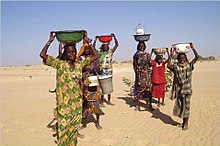Kanem (region)
14°07′10″N 15°18′48″E / 14.1194°N 15.3133°E
Kanem
كانم | |
|---|---|
 Map of Chad showing Kanem. | |
| Country | Chad |
| Departments | 3 |
| Sub-prefectures | 10 |
| Regional capital | Mao |
| Government | |
| • Governor | Ngamai Djari (2008) |
| Population (2009) | |
• Total | 354,603 |
Kanem (Arabic: كانم) is one of the 23 regions of Chad. It is named after the famous Kanem Empire, which was centred in this vicinity. The region's capital is Mao. It was created in 2002 from the former Prefecture of Kanem. In 2008, a portion of the Kanem region (the Bahr el Gazel Department) was split off to become the new Bahr el Gazel Region.
Geography
The region borders Borkou Region to the north, Bahr el Gazel Region to the east, Hadjer-Lamis Region and Lac Region to the south, and Niger to the west.
Settlements
Mao is the regional capital; other major settlements include Am Doback, Kekedina, Nokou, Ntiona, Rig Rig, Wadjigui and Ziguey.[1]
Demographics

As [er the census of 2009, the population in the region was 354,603, 51.4% female. The average size of household was 4.50: 4.50 in rural households and 4.90 in urban areas. The number of households was 78,145: 70,779 in rural areas and 7,366 in urban areas. The number of nomads in the region was 10,056, 2.6% of the population. There were 354,007 people residing in private households. There were 157,264 over 18 years of age: 70,134 male and 87,130 female. The sex ratio was 94.00 females for every hundred males. There were 344,547 sedentary staff, 3.20 of the population.
The principal ethnolinguistic groups are Baggara Arabs (4.97%), Dazaga Toubou (48.25%), Fula and Kanembu (40.54%).[2][3]
Economy
The region is the principal agricultural segment in the whole country, producing cotton and groundnuts, the two main cash crops of the country. There are a variety of local crops such as rice also grown in the region.[4]
Administration
Since 2008, the region of Kanem is divided in three departments, namely, Kanem (capital Mao), Nord Kanem (capital of Nokou) and Wadi Bissam (capital of Mondo). As a part of decentralization in February 2003, the country is administratively split into regions, departments, municipalities and rural communities. The prefectures which were originally 14 in number were re-designated in 17 regions. The regions are administered by Governors appointed by the President. The Prefects, who originally held the responsibility of the 14 prefects, still retained the titles and were responsible for the administration of smaller departments in each region. The members of local assemblies are elected every six years, while the executive organs are elected every three years.[5]
See also
References
- ^ "Tchad: Régions du Kanem et du Barh-el-Gazel (juillet 2016)" (PDF). UNOCHA. Retrieved 4 October 2019.
- ^ "Census of Chad". National Institute of Statistical, Economic and Demographic Studies, Chad. 2009. Archived from the original on 21 November 2016. Retrieved 17 November 2016.
- ^ "Languages of Chad". Ethnologue. Retrieved 27 September 2019.
- ^ Hilling, David (2004). "Chad - Physical and Social Geography". Africa South of the Sahara 2004. Psychology Press. p. 218. ISBN 9781857431834.
- ^ Republic of Chad Public Administration and Country profile (PDF) (Report). Department of Economic and Social Affairs (DESA), United Nations. 2004. p. 9. Retrieved 17 November 2016.
External links